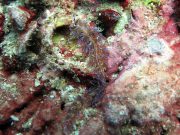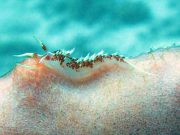Diving with Facelinidae Nudibranches
Lanta Marine Life | Facelinidae
Facelinidae Nudibranchs are colourful aeolid nudibranchs found at all dive sites around Koh Lanta.
Members of the superfamily of aeolid nudibranchs have many tapered blood-filled tubes growing from the dorsal (back) and lateral (side) areas of the body. These growths are called 'cerata'.
Cerata perform several functions and contain a duct of the digestive gland. These thin-walled, blood-filled structures also act as gills, and for those species eating corals and anemones, there is a poisonous stinging sac at the tip of the cerata used for defence.
Since a large part of the colour of these nudibranchs depends on the colour of the cerata, which in turn are also influenced by the diet, members of this family can change colour depending on what they eat.
Facelinidae Nudibranchs usually have a long, extended body (elongate), with the cerata usually arranged in arches or rows. Most species of this family feed on hydroids, from which they extract the stinging chemicals for use in their defensive stinging sacs.
2 species found on this page:
Blue Dragon
(Pteraeolidia ianthina)

Pteraeolidia ianthina @ Koh Bida
The Blue Dragon has an extremely long body with many clusters of cerata. Adults are of variable colouring, with blue to violet bands on the rhinophores (pair of tentacles on the head).
As juveniles, Blue Dragons are actually white, however as they grow, they seek out certain species of hydroids which contain particular zooxanthellae. The Blue Dragons consume the hydroids, extracting the zooxanthellae which are then stored within the cerata and live symbiotically with the Blue Dragon.
Through photosynthesis, the zooxanthellae provide both the colour (as they do with corals) and a large amount of sugars and nutrients for the Blue Dragon. Due to differences in the zooxanthellae, Blue Dragons can have a variable colour, however all species have blue to violet bands the tips of the rhinophores.
The Blue Dragon grows to 10 cm
Indian Phidiana
(Phidiana indica)

Phidiana indica @ Koh Haa
The Indian Phidiana has an opaque to translucent orangish head, with white lines. The distinctive cerate (blood-filled tubes growing from the back and sides) have a reddish base, followed by a blue band, and finally with a whitish or yellowish tip.
The Indian Phidiana grows to 5 cm.
The diet consists mostly of hydroids Salacia tetracythara and Pennaria sp.
Diving with Facelinidae Nudibranches around Koh Lanta
Scuba Diving & Snorkel Trips
If you'd love a chance to spot Facelinidae Nudibranches on one of our daily high season diving trips from Koh Lanta then send us an email to info@diveandrelax.com.
Join our high season speedboat dive trips to some of Thailand's best dive sites and enjoy small groups, short journey times, with a focus on great personal service, safety and fun.
Not yet a certified diver? Learn to Scuba Dive on Koh Lanta with the 3 day SSI Open Water Diver course.
Book online to save 10% on dive trips and scuba courses on Koh Lanta.
Find Out More
Indo-Pacific Marine Life Guides
- Allen, G., Steene, R., Humann, P., DeLoach, N. (2003) Reef Fish Identification, Tropical Pacific. Jacksonville, FL., USA: New World Publications, Inc., ISBN 1-878348-36-1.
- Humann, P., DeLoach, N., (2010) Reef Creature Identification, Tropical Pacific. Jacksonville, FL., USA: New World Publications Inc., ISBN 978-1-878348-44-9
- Debelius, H. (2013) Indian Ocean Reef Guide. Frankfurt, Germany: IKAN - Unterwasserarchiv, ISBN 978-3-939767-52-7.
- Debelius, H. (2004) Nudibranchs and Sea Snails, Indo-Pacific Field Guide. Frankfurt, Germany: IKAN - Unterwasserarchiv, ISBN 3-925919-51-1
- Erhardt, H., Knop, D. (2015) Corals Indo-Pacific Field Guide. Frankfurt, Germany: IKAN - Unterwasserarchiv, ISBN 3-925919-69-4.
- Veron J.E.N., Stafford-Smith M.G., Turak E. and DeVantier L.M. (2016). Corals of the World
